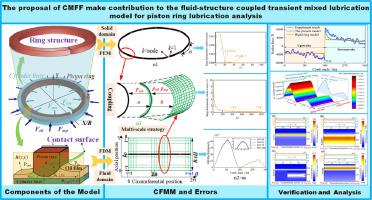International Journal of Mechanical Sciences ( IF 7.1 ) Pub Date : 2023-04-11 , DOI: 10.1016/j.ijmecsci.2023.108377 Bowen Jiao , Xuan Ma , Yongqiang Wang , Xiuyi Lyu , Tongyang Li , Zhigang Liu

|
The bore's circumferential cross-section is not always a perfect circle, due to manufacturing errors, installation, and the influence of high-temperature and high-pressure gas, especially for a cylinder liner of the two-stroke marine diesel engine. This non-axisymmetric feature significantly impacts the lubrication properties of the piston ring and cylinder liner tribo-pair. To study the tribology and lubrication properties of the tribo-pair, a fluid-structure coupled transient mixed lubrication model is developed, which incorporates the piston ring curved beam model and mixed lubrication model. The key challenge lies in integrating the interface contact issue between the piston ring and bore with the structural deformation, requiring a multi-scale modeling strategy. To address this challenge, a method of coupling mesh between the finite difference method and the finite element method (CMFF) is proposed. The approach achieves the requirement for a fine mesh for the interface contact solution while maintaining the accuracy of the curved beam model for the structural response of the piston ring. Based on the model, the lubrication performance and deformation behavior of the piston ring in an elliptical bore are comprehensively analyzed. The results are compared with those of the rigid ring model to explore the overall differences. Results reveal that the current model predicts the friction is mostly caused by asperity contact between solids at the top dead center, whereas the rigid ring model predicts viscous shearing of the lubricant. The discrepancy is mainly due to the reduction of the oil film thickness between the piston ring and the cylinder liner following the consideration of ring deformation. Moreover, the minimum clearance exhibited at the piston ring end gap demonstrates the thorough consideration of the local and global lubrication performance of piston rings in the proposed model. This is significant for the resolution of local friction and wear problems of piston rings in engineering applications. Based on the work, a new framework is established for the study of the coupled performance of piston ring dynamics and tribology.
中文翻译:

使用 CMFF 方法分析活塞环润滑性能的流固耦合瞬态混合润滑模型
尤其是二冲程船用柴油机缸套,由于制造误差、安装误差和高温高压气体的影响,缸孔的圆周截面并不一定是正圆。这种非轴对称特征显着影响活塞环和气缸套摩擦副的润滑性能。为了研究摩擦副的摩擦学和润滑特性,开发了一种流体-结构耦合瞬态混合润滑模型,该模型结合了活塞环曲梁模型和混合润滑模型。关键挑战在于将活塞环和孔之间的界面接触问题与结构变形结合起来,需要多尺度建模策略。为了应对这一挑战,提出了有限差分法与有限元法(CMFF)耦合网格的方法。该方法实现了对界面接触解的精细网格的要求,同时保持了活塞环结构响应的曲梁模型的准确性。基于该模型,综合分析了活塞环在椭圆孔内的润滑性能和变形行为。将结果与刚性环模型的结果进行比较,以探索整体差异。结果表明,当前模型预测摩擦主要由上止点处固体之间的粗糙接触引起,而刚性环模型预测润滑剂的粘性剪切。差异主要是由于考虑环变形后活塞环与缸套之间的油膜厚度减少所致。此外,活塞环端部间隙处的最小间隙表明,所提出的模型充分考虑了活塞环的局部和全局润滑性能。这对于解决活塞环在工程应用中的局部摩擦磨损问题具有重要意义。在此基础上,建立了活塞环动力学与摩擦学耦合性能研究的新框架。活塞环端部间隙处的最小间隙表明在所提出的模型中充分考虑了活塞环的局部和全局润滑性能。这对于解决活塞环在工程应用中的局部摩擦磨损问题具有重要意义。在此基础上,建立了活塞环动力学与摩擦学耦合性能研究的新框架。活塞环端部间隙处的最小间隙表明在所提出的模型中充分考虑了活塞环的局部和全局润滑性能。这对于解决活塞环在工程应用中的局部摩擦磨损问题具有重要意义。在此基础上,建立了活塞环动力学与摩擦学耦合性能研究的新框架。













































 京公网安备 11010802027423号
京公网安备 11010802027423号